Brin’s modern battleships
The two ships of the Margherita class, were the first large Italian modern battleships, designed in 1898 by Benedetto Brin, admiral, chief engineer and later minister of the navy.
They had to be powerful and fast, but at the cost of sacrificing some protection. Main armament was massive, since outside the usual two twin 305 mm (12 in) turrets, the secondary battery comprised no less than 12 x 203 mm (8 in) guns. However Brin passed out before he can put an end to his ambitious design. Naval Engineer Ruggero A. Micheli took over the blueprints and seeked a more reasonable caliber. The concept however will be kept and applied later to Regina Elena class.
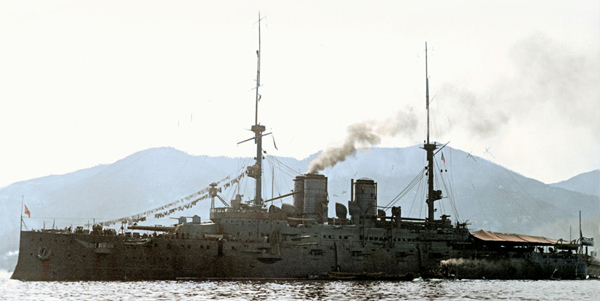
These ships were 2 knots faster than the previous class, agile and good sea going vessels due to their high freeboard. The symmetry of their initial design was intended to deceive gunners and submariners on the real direction of the ship at low speed. In terms of propulsion, the gain in speed was obtained by a simplification of the all-coal burning boilers and dropping of the old mixed system.
Started in 1898-99, launched in 1901 and completed in 1904-1905, these ships participated actively in the great war, the Margherita hitting two mines (UC14, December 11, 1916) off Valone, and the Brin sinking in Brindisi on September 27, 1915 because of an explosive charge laid by Austrian swimmers.
Final Design of the Regina Margherita
The whole philosophy behind this class was driven from the previous painful experience of the “cheap” Ammiraglio di Saint Bon class.
They proved at the same time too weak to engage foreign battleships and too slow to catch cruisers. The admiralty wanted a larger ship, of effective size in particular to answer to the new Habsburg-class battleships from Austria-Hungary. First, they wanted the 12-inch (305 mm) artillery back, but at the same time were ready to accept a loss in armor protection to achieve the required speed.
In short, these ships were a crossover of a cruiser and proper battleships, glorified armoured cruisers or early battle cruisers. Benedetto Brin initial design was even more radical, with only two 12-inch guns but twelve 8 in (203 mm) guns. After he passed out, Admiral Ruggero Alfredo Micheli modified the design in a more conventional way, and probably for the best.
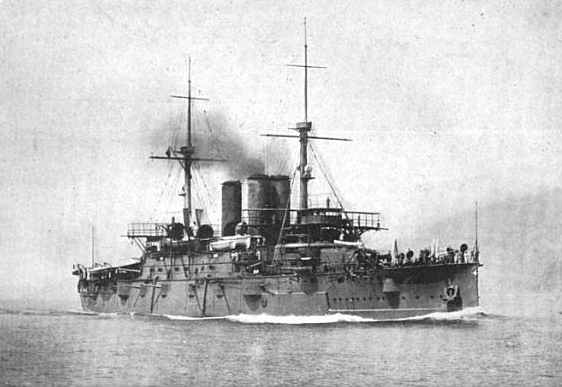
In its final form these ships were 13,215 t (13,006 long tons; 14,567 short tons) empty and 14,093 to 14,737 t (13,870 to 14,504 long tons; 15,535 to 16,245 short tons) fully loaded and dimensiosn were 138.65 m (454 ft 11 in) in lenght, 23.84 m (78 ft 3 in) to the beam with a draft of 8.81 to 9 m (28 ft 11 in to 29 ft 6 in). They had an installed power of 21,790 ihp (16,249 kW) for 2 shafts, driven by two triple expansion steam engines, the steam coming from coal firing 28 boilers with three funnels, two in a forward pair and a single one at the rear.
Top speed was therefore 20 knots (37 km/h; 23 mph) and range 10,000 nmi (18,520 km; 11,508 mi) at 10 kn (19 km/h; 12 mph) for a complement of 812–900. Main armament was two twin 305 mm (12 in)/40 guns, secondary armament comprised in the final form only four 203 mm (8 in)/45 guns in deck barbettes on the four corners of the superstructure, then twelve 152 mm (6 in)/40 guns, twenty 76 mm (3 in)/40 guns, two 47 mm (1.9 in)/40 guns, two 37 mm (1.5 in)/40 guns and four 450 mm (17.7 in) torpedo tubes above the waterline, broadside (For conways, underwater).
The choice of having lower caliber spared probably some structural and stability problems. Protection consisted in Harvey steel armour plating manufactured in Terni, 6in (152 mm) on the belt and side, 3.1 in (78.7 mm) on the deck, 8 in (203 mm) turrets, and 6 in (152 mm) for the conning tower and casemates. This was light to say the least, whereas 20 knots was not precisely outstanding. Coal was used to contribute extensively in the protection, laid in the internal double hull as a cushion to prevent underwater damage.
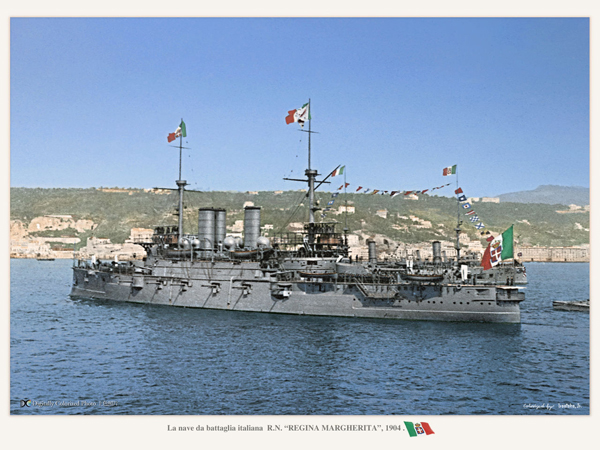
Margherita class specifications |
|
| Dimensions | 138.65 m x 23.84 m x 8.81/9 m |
| Displacement | 13,215t empty, 14,737t FL |
| Crew | 812 |
| Propulsion | 2 VTE engines, 28 boilers, 21,800 hp. |
| Speed | 20 knots max. (37 km/h; 23 mph) |
| Range | 10,000 nmi (18,520 km; 11,508 mi) at 10 kn (19 km/h; 12 mph) |
| Armament | 4 x 305 (2×2), 4 x 203, 12 x 152, 20 x 76 mm, 2 x 47mm, 2 x 37mm, 2 MG, 4 TT 450 mm aw bd* |
| Armor | Battery 152, Belt 152, Turrets 203, Main Deck 80 mm |
The Regina Margherita in action
Regina Margherita was laid down at La Spezia on 20 November 1898, was launched on 30 May 1901 and completed in 1904, commissioned on 14 April 1904. The slow completion was due partly to material being not delivered and especially the heavy armor.
The ship started her speed trials in the Gulf of Genoa during the summer and afterwards joined the Mediterranean Squadron. At that time budget constraints meant the ships were in active duty for seven months, training and in reserve with a skeleton crew the rest of the year. The Squadron comprised also the three brand new Regina Elena-class battleships and they participated in annual winter maneuvers in 1907, 1908 and 1909.
Margherita served as flagship of Vice Admiral Alfonso di Brocchetti. A few years later, on 29 September 1911, war broke out with the Ottoman Empire. Libya. became the target of the Italian fleet, and Regina Mergherita joined the 1st Division, 2nd Squadron with both Ammiraglio di Saint Bon-class battleships in October. The two squadrons joined forced at Stampalia (Aegean) on 17 April, and raided the northern Aegean, cutting Turkish submarine cables and shelling the Dardanelles fortresses.
Unfortunately, this move to drive the Turkish fleet in open see did not succeed. Both ships from then on went to cut other cables around Rhodes and Marmaris, the latter being shelled in the meantime and troops landed to seize the island of Scarpanto. The ships then retired to being re-barreled and in 1912, receiving four additional 3-inch guns.
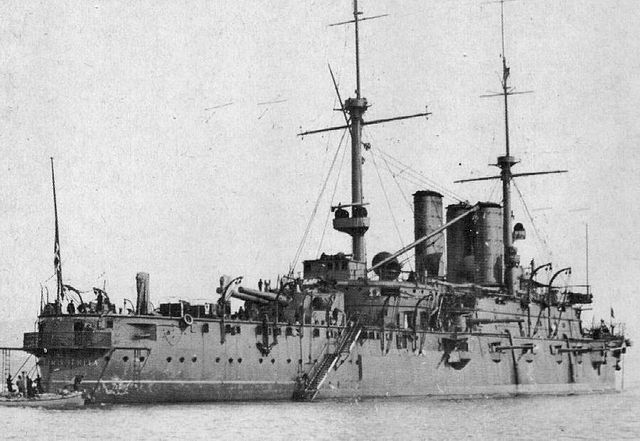
Regina Margherita circa 1908
Italy was neutral in August 1914, but by July 1915 was at wa, facing the the Austro-Hungarian Navy. Admiral Paolo Thaon di Revel planned a blockade in the adriatic but with smal vessels, preserving the capital ships for a potential decisive battle with the Austro-Hungarian navy. Regina Margherita however was being reduced to a training ship with the 3rd Division. She met her fate however in the night of 11–12 December 1916 sailing in heavy seas off Valona and striking two mines laid by SM UC-14. She blew up and capsized, carrying with her 675 men but her loss was only announced in January 1917.
The Benedetto Brin in action
Named after the famous admiral and engineer, this ship was laid down at the Castellammare di Stabia shipyard on 30 January 1899, launched on 7 November 1901 but fitting out lasted for the next four years because of materials and armor shortage so she was completed only by 1 September 1905. She served right away with the Mediterranean Squadron, and on service for seven months alternated with reserve. After the the winter maneuvers and on 29 September 1911, was thrown in the conflict opposing Italy to the Ottoman Empire.
Benedetto Brin served with the 1st Division, 2nd Squadron, squadron flagship of Vice Admiral Farvelli. By October, she relieve Roma blockading Tripoli, and later shelled its fortifications with her medium-caliber guns and was never threated by the weak counter-battery fire. On April 1912 she sailed from Tobruk to the Aegean Sea and met the 1st Squadron off Stampalia, joining the northern Aegean to cut Turkish submarine telegraph cables and shelled the Dardanelles fortresses. She went back to italy afterwards to replace worn-out gun barrels in Italy and received four exta four 3-inch guns.
When Italy was at war during WW1, Brin was reduced to inaction and served as a training ship with the 3rd Division in Brindisi. However On 27 September 1915, she was destroyed ant anchor by a massive explosion. It was at first though the work of an Austro-Hungarian swimmer but the enquiry was re-opened recently and the Italian Navy experts concluded to an accident to me the mostly likely cause. 454 died in the explosion including Rear-Admiral Rubin de Cervin. Later 12-inch guns were salvaged and reused in fortresses protecting Venice.
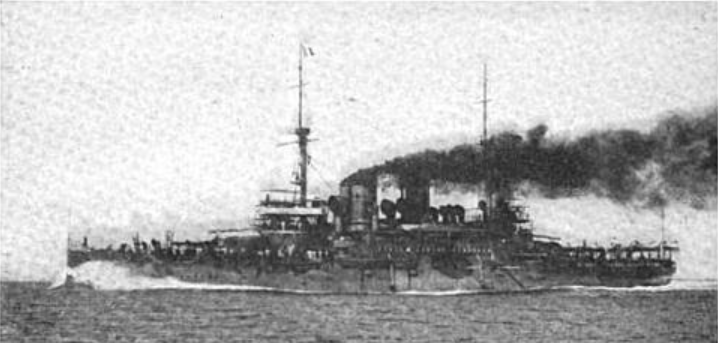

Author’s illustration of the Margherita class
Read More
https://en.wikipedia.org/wiki/Regina_Margherita-class_battleship


 Latest Facebook Entry -
Latest Facebook Entry -  X(Tweeter) Naval Encyclopedia's deck archive
X(Tweeter) Naval Encyclopedia's deck archive Instagram (@navalencyc)
Instagram (@navalencyc)





 French Navy
French Navy Royal Navy
Royal Navy Russian Navy
Russian Navy Armada Espanola
Armada Espanola Austrian Navy
Austrian Navy K.u.K. Kriegsmarine
K.u.K. Kriegsmarine Dansk Marine
Dansk Marine Nautiko Hellenon
Nautiko Hellenon Koninklije Marine 1870
Koninklije Marine 1870 Marinha do Brasil
Marinha do Brasil Osmanlı Donanması
Osmanlı Donanması Marina Do Peru
Marina Do Peru Marinha do Portugal
Marinha do Portugal Regia Marina 1870
Regia Marina 1870 Nihhon Kaigun 1870
Nihhon Kaigun 1870 Preußische Marine 1870
Preußische Marine 1870 Russkiy Flot 1870
Russkiy Flot 1870 Svenska marinen
Svenska marinen Søværnet
Søværnet Union Navy
Union Navy Confederate Navy
Confederate Navy Armada de Argentina
Armada de Argentina Imperial Chinese Navy
Imperial Chinese Navy Marinha do Portugal
Marinha do Portugal Mexico
Mexico Kaiserliche Marine
Kaiserliche Marine 1898 US Navy
1898 US Navy Sovietskiy Flot
Sovietskiy Flot Royal Canadian Navy
Royal Canadian Navy Royal Australian Navy
Royal Australian Navy RNZN Fleet
RNZN Fleet Chinese Navy 1937
Chinese Navy 1937 Kriegsmarine
Kriegsmarine Chilean Navy
Chilean Navy Danish Navy
Danish Navy Finnish Navy
Finnish Navy Hellenic Navy
Hellenic Navy Polish Navy
Polish Navy Romanian Navy
Romanian Navy Turkish Navy
Turkish Navy Royal Yugoslav Navy
Royal Yugoslav Navy Royal Thai Navy
Royal Thai Navy Minor Navies
Minor Navies Albania
Albania Austria
Austria Belgium
Belgium Columbia
Columbia Costa Rica
Costa Rica Cuba
Cuba Czechoslovakia
Czechoslovakia Dominican Republic
Dominican Republic Haiti
Haiti Hungary
Hungary Honduras
Honduras Estonia
Estonia Iceland
Iceland Eire
Eire Equador
Equador Iran
Iran Iraq
Iraq Latvia
Latvia Liberia
Liberia Lithuania
Lithuania Mandchukuo
Mandchukuo Morocco
Morocco Nicaragua
Nicaragua Persia
Persia San Salvador
San Salvador Sarawak
Sarawak Uruguay
Uruguay Venezuela
Venezuela Zanzibar
Zanzibar Warsaw Pact Navies
Warsaw Pact Navies Bulgaria
Bulgaria Hungary
Hungary

 Bundesmarine
Bundesmarine Dutch Navy
Dutch Navy Hellenic Navy
Hellenic Navy Marina Militare
Marina Militare Yugoslav Navy
Yugoslav Navy Chinese Navy
Chinese Navy Indian Navy
Indian Navy Indonesian Navy
Indonesian Navy JMSDF
JMSDF North Korean Navy
North Korean Navy Pakistani Navy
Pakistani Navy Philippines Navy
Philippines Navy ROKN
ROKN Rep. of Singapore Navy
Rep. of Singapore Navy Taiwanese Navy
Taiwanese Navy IDF Navy
IDF Navy Saudi Navy
Saudi Navy Royal New Zealand Navy
Royal New Zealand Navy Egyptian Navy
Egyptian Navy South African Navy
South African Navy






























 Ukrainian Navy
Ukrainian Navy dbodesign
dbodesign
Torpedo tube arrangement isn’t mentioned. Were they bow/stern or they on the broadsides?
That’s a tricky question because sources are contradicting themselves. Conway’s says they were underwater, other sources that thay are above water. Seeing this model (https://upload.wikimedia.org/wikipedia/commons/6/61/Model_of_Regina_Margherita_class_battleship.jpg), if you observe carefully there are two black dots just above the waterline, one aft at the vertical of the barbette, another in between funnels, but they can’t be tubes as right in the belt. Sub tubes also contradicts the pattern observed, even on conways, all Italian BBs until then had above water tubes. Nevertheless this post is fairly old and in need of a rewrite and expansion, which will be done this or next year. All the best !